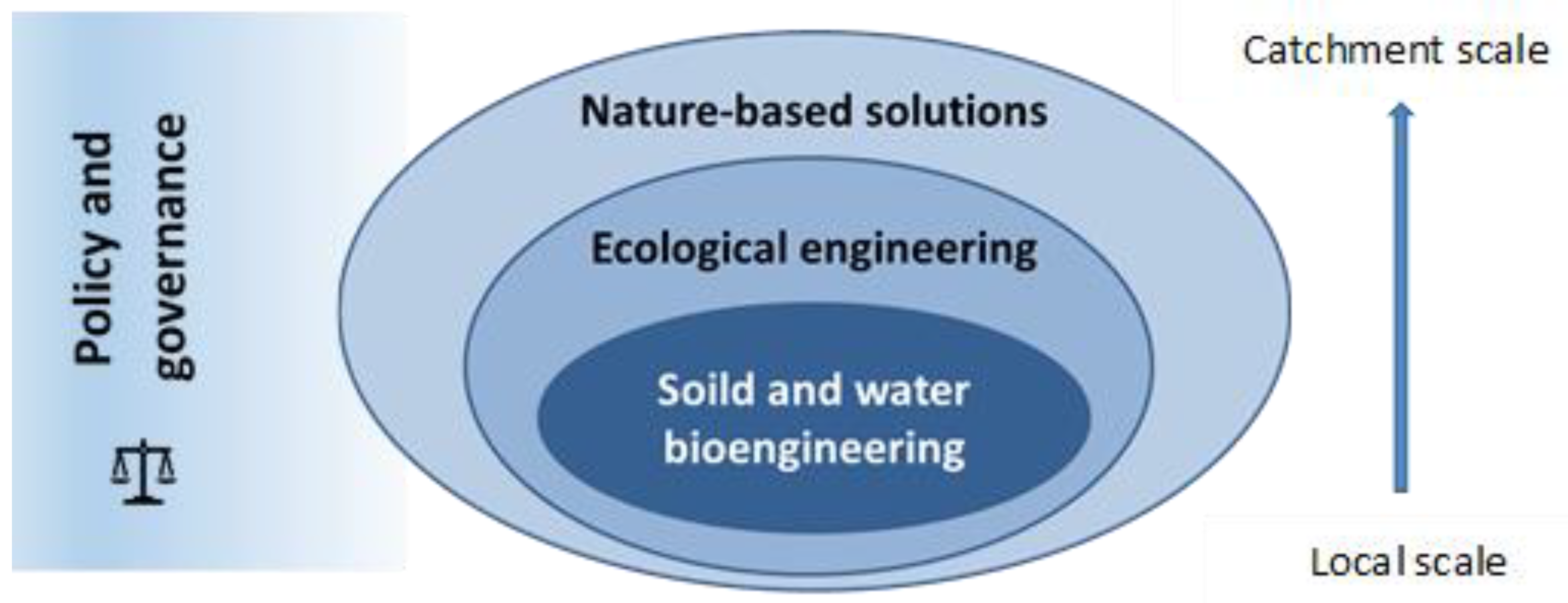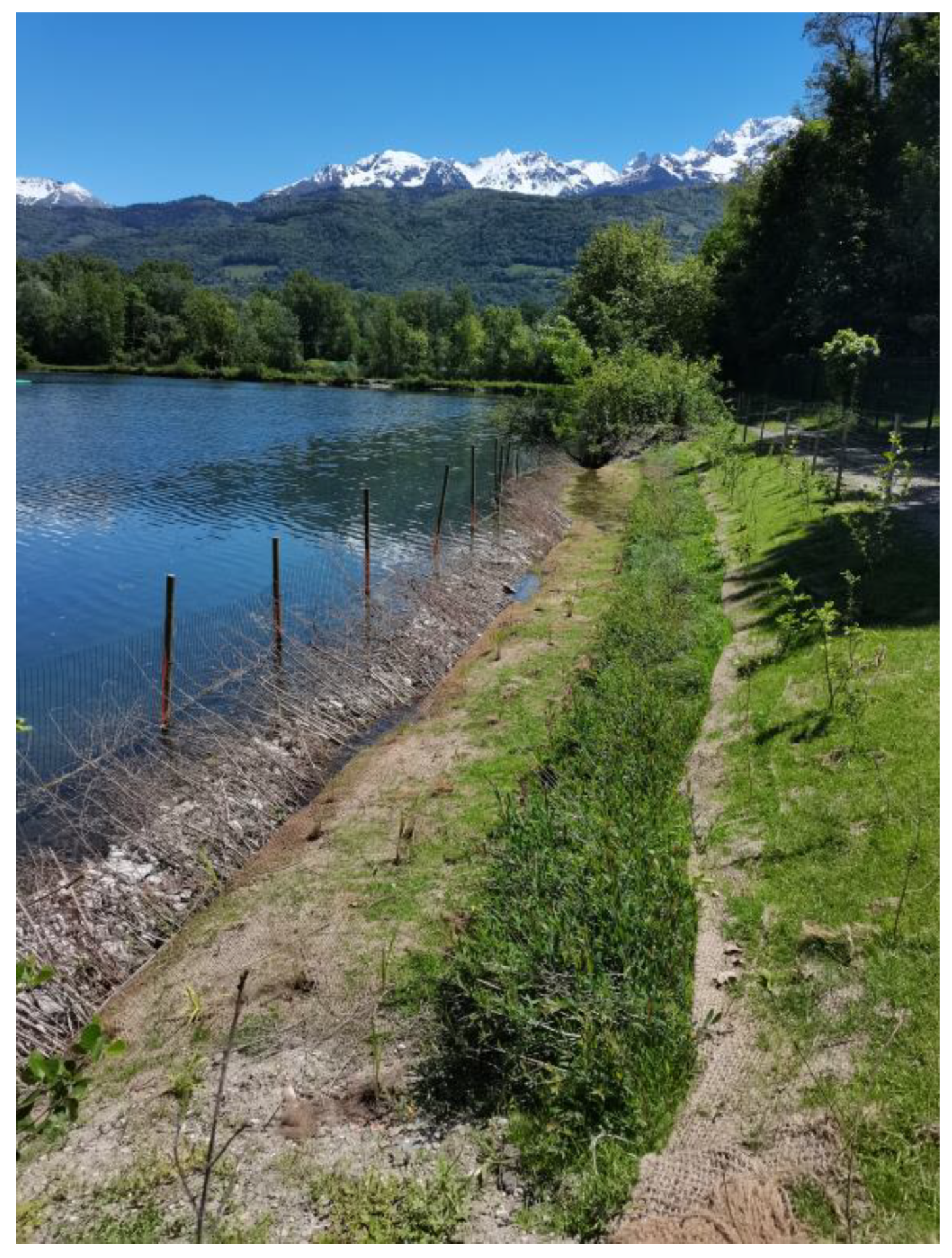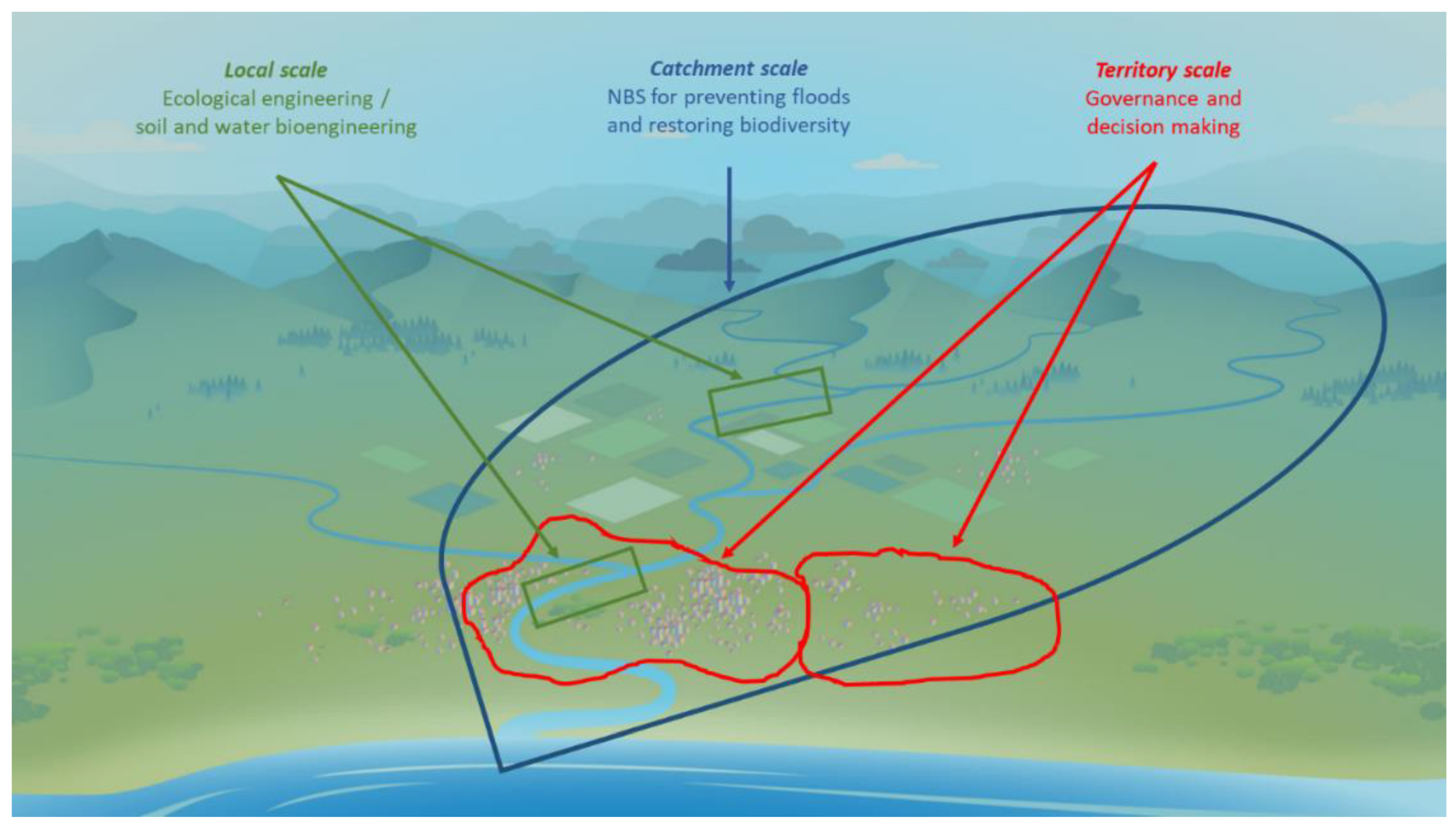Harmonizing Erosion Control and Flood Prevention with Restoration of Biodiversity through Ecological Engineering Used for Co-Benefits Nature-Based Solutions
Abstract
1. Introduction on Concepts
2. Exploring the Use of Local Ecological Measures Combined with Civil Engineering, for Either Erosion Control, Flood Prevention, or Restoration of Biodiversity
3. NBS for Harmonizing Erosion Control and Flood Prevention with Restoration of Biodiversity
4. Defining Effective NBS Actions at the Catchment Scale
5. Considering an Interdisciplinary and Transdisciplinary Approach for NBS Projects Dedicated to Erosion Control and Flood Prevention with Restoration of Biodiversity
6. Challenges for Research in Engineering Ecology and Geosciences
7. Conclusions
8. Highlights
Funding
Institutional Review Board Statement
Informed Consent Statement
Data Availability Statement
Conflicts of Interest
References
- Schanze, J. Nature-based solutions in flood risk management—Buzzword or innovation? J. Flood Risk Manag. 2017, 10, 281–282. [Google Scholar] [CrossRef]
- Lin, Z.; Qi, J. Hydro-dam—A nature-based solution or an ecological problem: The fate of the Tonlé Sap Lake. Environ. Res. 2017, 158, 24–32. [Google Scholar] [CrossRef]
- Lafortezza, R.; Sanesi, G. Nature-based solutions: Settling the issue of sustainable urbanization. Environ. Res. 2019, 172, 394–398. [Google Scholar] [CrossRef]
- Dobson, A.P.; Bradshaw, A.D.; Baker, A.J.M. Hopes for the future: Restoration ecology and conservation biology. Science 1997, 277, 515–522. [Google Scholar] [CrossRef]
- Clewell, A.F.; Aronson, J. Ecological Restoration: Principles, Values, and Structure of an Emerging Profession; Society for Ecological Restoration: Washington, DC, USA, 2013; 336p. [Google Scholar]
- Eggermont, H.; Balian, E.; Azevedo, J.M.N.; Beumer, V.; Brodin, T.; Claudet, J.; Fady, B.; Grube, M.; Keune, H.; Lamarque, P.; et al. Nature-based Solutions: New Influence for Environmental Management and Research in Europe. GAIA 2015, 24, 243–248. [Google Scholar] [CrossRef]
- Nesshöver, C.; Assmuth, T.; Irvine, K.; Rusch, G.; Waylen, K.; Delbare, B.; Haase, D.; Jones-Walters, L.; Keune, H.; Kovacs, E.; et al. The science, policy and practice of Nature-Based Solutions: An interdisciplinary perspective. Sci. Total Environ. 2017, 579, 1215–1227. [Google Scholar] [CrossRef]
- IUCN French Committee. Nature-Based Solutions for Climate Change Adaptation and Disaster Risk Reduction; IUCN French Committee: Paris, France, 2019. [Google Scholar]
- Ruangpan, L.; Vojinovic, Z.; Di Sabatino, S.; Sandra Leo, L.; Capobianco, V.; Oen, A.M.P.; McClain, M.E.; Lopez-Gunn, E. Nature-based solutions for hydro-meteorological risk reduction: A state-of-the-art review of the research area. Nat. Hazards Earth Syst. Sci. 2020, 20, 243–270. [Google Scholar] [CrossRef]
- Mitsch, W.J. What is ecological engineering? Ecol. Eng. 2012, 45, 5–12. [Google Scholar] [CrossRef]
- Abdallah, M.A.B.; Mata-Gonzalez, R.; Noller, J.S.; Ochoa, C.G. Ecosystem carbon in relation to woody plant encroachment and control: Juniper systems in Oregon, USA. Agric. Ecosyst. Environ. 2020, 290, 106762. [Google Scholar] [CrossRef]
- Mata-González, R.; Abdallah, M.A.B.; Ochoa, C.G. Water use by mature and sapling western juniper (Juniperus occidentalis) trees. Rangel. Ecol. Manag. 2021, 74, 110–113. [Google Scholar] [CrossRef]
- Costanza, R.; D’arge, R.; de Groot, R.; Farber, S.; Grasso, M.; Hannon, B.; Limburg, K.; Naeem, S.; O’Neill, R.V.; Paruelo, J.; et al. The value of the world’s ecosystem services and natural capital. Nature 1997, 387, 253–260. [Google Scholar] [CrossRef]
- Keesstra, S.; Nunes, J.; Novara, A.; Finger, D.; Avelar, D.; Kalantari, Z.; Cerda, A. The superior effect of nature based solutions in land management for enhancing ecosystem services. Sci. Total. Environ. 2018, 610–611, 997–1009. [Google Scholar] [CrossRef] [PubMed]
- Rey, F.; Cécillon, L.; Cordonnier, T.; Jaunatre, R.; Loucougaray, G. Integrating ecological engineering and ecological intensification from practice to ecosystem services into a generic framework: A review. Agron. Sustain. Dev. 2015, 35, 1335–1345. [Google Scholar] [CrossRef]
- Maxwald, M.; Crocetti, C.; Ferrari, R.; Petrone, A.; Rauch, H.P.; Preti, F. Soil and water bioengineering applications in Central and South America: A transferability analysis. Sustainability 2020, 12, 10505. [Google Scholar] [CrossRef]
- Stokes, A.; Spanos, I.; Norris, J.E.; Cammeraat, E. (Eds.) Eco- and Ground Bio-Engineering: The Use of Vegetation to Improve Slope Stability: Proceedings of the First International Conference on Eco-Engineering 13–17 September 2004; Springer Science & Business Media: Berlin/Heidelberg, Germany, 2007. [Google Scholar]
- Fernandes, J.P.; Guiomar, N. Nature-based solutions: The need to increase the knowledge on their potentialities and limits. Land Degrad. Dev. 2018, 29, 1925–1939. [Google Scholar] [CrossRef]
- Rey, F.; Bifulco, C.; Bischetti, G.B.; Bourrier, F.; de Cesare, G.; Florineth, F.; Graf, F.; Marden, M.; Mickovski, S.; Phillips, C.; et al. Soil and water bioengineering: Practice and research needs for reconciling natural hazard control and ecological restoration. Sci. Total Environ. 2019, 648, 1210–1218. [Google Scholar] [CrossRef]
- Mickovski, S.B. Re-thinking soil bioengineering to address climate change challenges. Sustainability 2021, 13, 3338. [Google Scholar] [CrossRef]
- EFIB. European Guidelines for Soil and Water Bioengineering; European Federation of Soil Bioengineering: Vienna, Austria, 2015. [Google Scholar]
- Tardio, G.; Mickovski, S.B. Method for synchronisation of soil and root behaviour for assessment of stability of vegetated slopes. J. Ecol. Eng. 2015, 82, 222–230. [Google Scholar] [CrossRef][Green Version]
- Schiechtl, H.M.; Stern, R. Ground Bioengineering Techniques for Slope Protection and Erosion Control; Blackwell Science: Oxford, UK, 1996; 146p. [Google Scholar]
- Schiechtl, H.M.; Stern, R. Water Bioengineering Techniques for Watercourse Bank and Shoreline Protection; Blackwell Science: Oxford, UK, 1997; 186p. [Google Scholar]
- Gray, D.H.; Sotir, R.B. Biotechnical and Soil Bioengineering Slope Stabilization: A Practical Guide for Erosion Control; John Wiley & Sons: New York, NY, USA, 1996. [Google Scholar]
- Stokes, A.; Douglas, G.; Fourcaud, T.; Giadrossich, F.; Gillies, C.; Hubble, T.; Kim, J.H.; Loades, K.; Mao, Z.; Mcivor, I.; et al. Ecological mitigation of hillslope instability: Ten key issues facing practitioners and researchers. Plant Soil 2014, 377, 1–23. [Google Scholar] [CrossRef]
- Gonzalez-Hidalgo, J.C.; Penna-Monné, J.L.; De Luis, M. A review of daily soil erosion in Western Mediterranean areas. Catena 2007, 71, 193–199. [Google Scholar] [CrossRef]
- Pimentel, D. World Soil Erosion and Conservation; Cambridge University Press: Cambridge, UK, 1993. [Google Scholar]
- Mkanda, F.X. Contribution by farmers’ survival strategies to soil erosion in the Linthipe River Catchment: Implications for biodiversity conservation in Lake Malawi/Nyasa. Biodivers. Conserv. 2002, 11, 1327–1359. [Google Scholar] [CrossRef]
- Steiger, J.; Gurnell, A.M.; Petts, G.E. Sediment deposition along the channel margins of a reach of the middle river Severn, UK. River Res. Appl. 2001, 17, 443–460. [Google Scholar] [CrossRef]
- Schleiss, A.J.; Franca, M.J.; Juez, C.; De Cesare, G. Reservoir sedimentation, vision paper. J. Hydraul. Res. 2016, 54, 595–614. [Google Scholar] [CrossRef]
- Schwarz, M.; Poesen, J.; Rey, F.; Hobling, D.; Phillips, P. Bio-Physical Performance of Erosion and Sediment Control/Mitigation Techniques—An International Comparison to Common Practices in New Zealand; STEC Program: Lincoln, New Zealand, 2020. [Google Scholar]
- Santoro, S.; Pluchinotta, I.; Pagano, A.; Pengal, P.; Cokan, B.; Giordano, R. Assessing stakeholders’ risk perception to promote Nature Based Solutions as flood protection strategies: The case of the Glinščica River (Slovenia). Sci. Total Environ. 2019, 655, 188–201. [Google Scholar] [CrossRef] [PubMed]
- Short, C.; Clarke, L.; Carnelli, F.; Uttley, C.; Smith, B. Capturing the multiple benefits associated with nature-based solutions: Lessons from a natural flood management project in the Cotswolds, UK. Land Degrad. Dev. 2017, 30, 241–252. [Google Scholar] [CrossRef]
- Albert, C.; Schroter, B.; Haase, D.; Brillinger, M.; Henze, J.; Herrmann, S.; Gottwald, S.; Guerrero, P.; Nicolas, C.; Matzdorf, B. Addressing societal challenges through nature-based solutions: How can landscape planning and governance research contribute? Landsc. Urban Plan. 2019, 182, 12–21. [Google Scholar] [CrossRef]
- Senhoury, A.; Niang, A.; Diouf, B.; Thomas, Y.F. Managing flood risks using nature-based solutions in Nouakchott, Mauritania. Adv. Nat. Technol. Hazard Res. 2016, 42, 435–455. [Google Scholar]
- Accastello, C.; Blanc, S.; Brun, F. A framework for the integration of Nature-based solutions into environmental risk management strategies. Sustainability 2019, 11, 489. [Google Scholar] [CrossRef]
- Thorslund, J.; Jarsjo, J.; Jaramillo, F.; Jawitzm, J.W.; Manzoni, S.; Basu, N.B.; Chalov, S.R.; Cohen, M.J.; Creed, I.F.; Goldenberg, R.; et al. Wetlands as large-scale nature-based solutions: Status and challenges for research, engineering and management. Ecol. Eng. 2017, 108, 489–497. [Google Scholar] [CrossRef]
- Dondajewska, R.; Kozak, A.; Budzyńska, A.; Kowalczewska-Madura, K.; Gołdyn, R. Nature-based solutions for protection and restoration of degraded Bielsko Lake. Ecohydrol. Hydrobiol. 2018, 18, 401–411. [Google Scholar] [CrossRef]
- Zalewski, M.; Arduino, G.; Bidoglio, G.; Junk, W.; Cullmann, J.; Uhlenbrook, S.; Xia, J.; de Leaniz, C.G.; Rowinski, P.M.; Vörösmarty, C.J.; et al. Low cost, nature-based solutions for managing aquatic resources: Integrating the principles of Ecohydrology and the Circular Economy. Ecohydrol. Hydrobiol. 2018, 18, 309–310. [Google Scholar] [CrossRef]
- Paquier, A.; Royer, Q.; Poulard, C.; Billy, P. Defining Uncertainty for a Simplified Method Dedicated to the Mapping of Extreme Floods. In Advances in Hydroinformatics; Gourbesville, P., Caignaert, G., Eds.; Springer: Singapore, 2020. [Google Scholar]
- Guerrero, P.; Haase, D.; Albert, C. Locating spatial opportunities for nature-based solutions: A river landscape application. Water 2018, 10, 1869. [Google Scholar] [CrossRef]
- Krauze, K.; Wagner, I. From classical water-ecosystem theories to nature-based solutions—Contextualizing nature-bases solutions for sustainable city. Sci. Total Environ. 2019, 655, 697–706. [Google Scholar] [CrossRef]
- Le Coent, P.; Graveline, N.; Altamirano, M.A.; Arfaoui, N.; Benitez-Avila, C.; Biffin, T.; Calatrava, J.; Dartee, K.; Douai, A.; Gnonlonfin, A.; et al. Is-it worth investing in NBS aiming at reducing water risks? Insights from the economic assessment of three European case studies. Nat.-Based Solut. 2021, 1, 100002. [Google Scholar] [CrossRef]
- Jaunatre, R.; Gaucherand, S.; Rey, F.; Guérold, F.; Muller, S. ASPIRE: Un cadre méthodologique pour l’Appréciation du Succès des Projets d’Ingénierie et de Restauration Ecologiques—Application à une opération de restauration d’une zone humide d’altitude. Sci. Eaux Territ. 2017, 24, 52–57. (In French) [Google Scholar] [CrossRef]
- Pelorosso, R.; Gobattoni, F.; Leone, A. Increasing hydrological resilience employing nature-based solutions: A modelling approach to support spatial planning. Green Energy Technol. 2018, 71–82. [Google Scholar] [CrossRef]
- Maes, J.; Jacobs, S. Nature-based solutions for Europe’s sustainable development. Conserv. Lett. 2017, 10, 121–124. [Google Scholar] [CrossRef]
- Raymond, C.M.; Frantzeskaki, N.; Kabisch, N.; Berry, P.; Breil, P.; Nita, M.R.; Geneletti, D.; Calfapietra, C. A framework for assessing and implementing the co-benefits of nature-based solutions in urban areas. Environ. Sci. Policy 2017, 77, 15–24. [Google Scholar] [CrossRef]
- Young, A.F.; Marengo, J.A.; Coelho, J.O.M.; Scofield, G.B.; Silva, C.C.O.; Prieto, C.C. The role of nature-based solutions in disaster risk reduction: The decision maker’s perspectives on urban resilience in Sao Paulo state. Int. J. Disaster Risk Reduct. 2019, 39, 101219. [Google Scholar] [CrossRef]
- Cohen-Shacham, E.; Andrade, A.; Dalton, J.; Dudley, N.; Jones, M.; Kumar, C.; Maginnis, S.; Maynard, S.; Nelson, C.R.; Renaud, F.G.; et al. Core principles for successfully implementing and upscaling Nature-based Solutions. Environ. Sci. Policy 2019, 98, 20–29. [Google Scholar] [CrossRef]
- Di Maiolo, P.; Curt, C.; Meriaux, P.; Vennetier, M.; Le Coarer, Y.; Gourhand, A.; Gand, C.; Prouteau-Hoffmann, J.; Ruhl, C.; Vassas, C. Method for the rapid assessment and potential mitigation of the environmental effects of development actions in riparian zone. J. Environ. Manag. 2020, 276, 111187. [Google Scholar]
- Marchal, R.; Piton, G.; Lopez-Gunn, E.; Zorrilla-Miras, P.; Van Der Keur, P.; Dartee, K.W.J.; Pengal, P.; Matthews, J.H.; Tacnet, J.M.; Graveline, N.; et al. The (Re)Insurance Industry’s Roles in the Integration of Nature-Based Solutions for Prevention in Disaster Risk Reduction—Insights from a European Survey. Sustainability 2019, 11, 6212. [Google Scholar] [CrossRef]
- Lupp, G.; Zingraff-Hamed, A.; Huang, J.J.; Oen, A.; Pauleit, S. Living Labs—A Concept for Co-Designing Nature-Based Solutions. Sustainability 2021, 13, 188. [Google Scholar] [CrossRef]
- Van Den Bosch, M.; Ode Sang, Å. Urban natural environments as nature-based solutions for improved public health—A systematic review of reviews. Environ. Res. 2017, 158, 373–384. [Google Scholar] [CrossRef] [PubMed]
- Liquete, C.; Udias, A.; Conte, G.; Grizetti, B.; Masi, F. Integrated valuation of a nature-based solution for water pollution control. Highlighting hidden benefits. Ecosyst. Serv. 2016, 22, 392–401. [Google Scholar] [CrossRef]
- Kabisch, N.; Frantzeskaki, N.; Pauleit, S.; Naumann, S.; Davis, M.; Artmann, M.; Haase, D.; Knapp, S.; Korn, H.; Stadler, J.; et al. Nature-based solutions to climate change mitigation and adaptation in urban areas: Perspectives on indicators, knowledge gaps, barriers, and opportunities for action. Ecol. Soc. 2016, 21, 39. [Google Scholar] [CrossRef]
- Seddon, N.; Chausson, A.; Berry, P.; Girardin, C.A.J.; Smith, A.; Turner, B. Understanding the value and limits of nature-based solutions to climate change and other global challenges. Philos. Trans. R. Soc. 2020, 375. [Google Scholar] [CrossRef] [PubMed]




Publisher’s Note: MDPI stays neutral with regard to jurisdictional claims in published maps and institutional affiliations. |
© 2021 by the author. Licensee MDPI, Basel, Switzerland. This article is an open access article distributed under the terms and conditions of the Creative Commons Attribution (CC BY) license (https://creativecommons.org/licenses/by/4.0/).
Share and Cite
Rey, F. Harmonizing Erosion Control and Flood Prevention with Restoration of Biodiversity through Ecological Engineering Used for Co-Benefits Nature-Based Solutions. Sustainability 2021, 13, 11150. https://doi.org/10.3390/su132011150
Rey F. Harmonizing Erosion Control and Flood Prevention with Restoration of Biodiversity through Ecological Engineering Used for Co-Benefits Nature-Based Solutions. Sustainability. 2021; 13(20):11150. https://doi.org/10.3390/su132011150
Chicago/Turabian StyleRey, Freddy. 2021. "Harmonizing Erosion Control and Flood Prevention with Restoration of Biodiversity through Ecological Engineering Used for Co-Benefits Nature-Based Solutions" Sustainability 13, no. 20: 11150. https://doi.org/10.3390/su132011150
APA StyleRey, F. (2021). Harmonizing Erosion Control and Flood Prevention with Restoration of Biodiversity through Ecological Engineering Used for Co-Benefits Nature-Based Solutions. Sustainability, 13(20), 11150. https://doi.org/10.3390/su132011150




